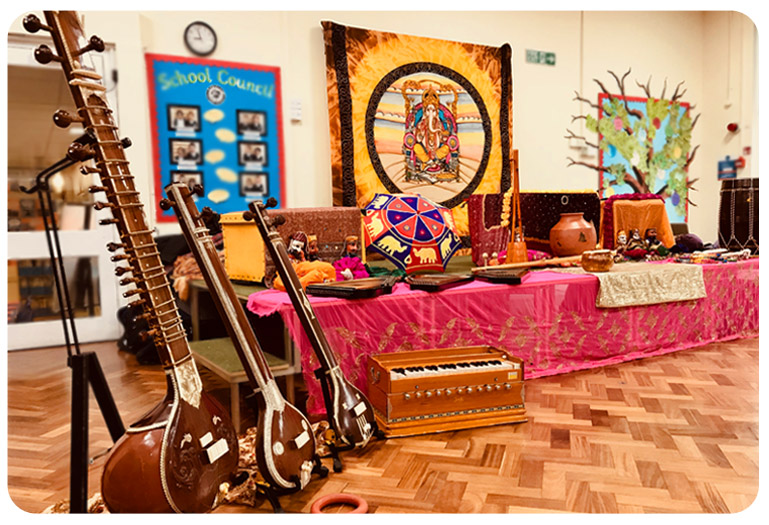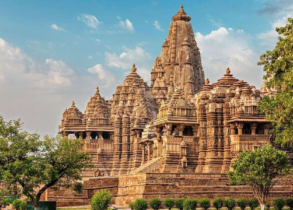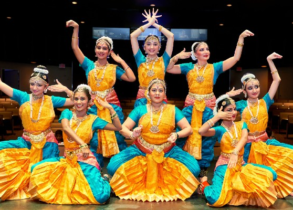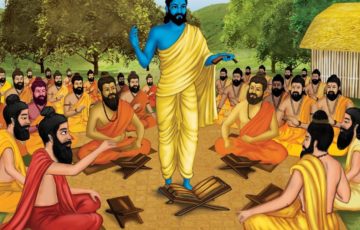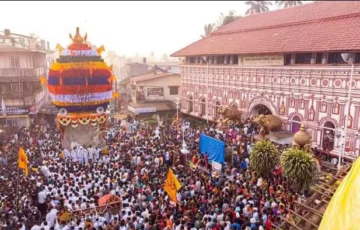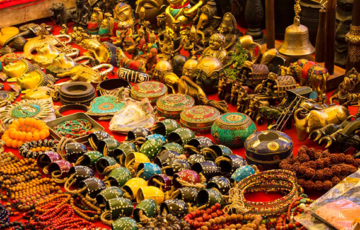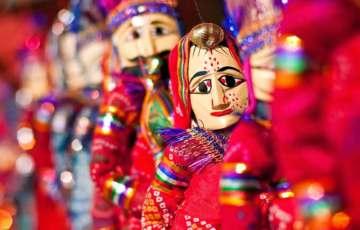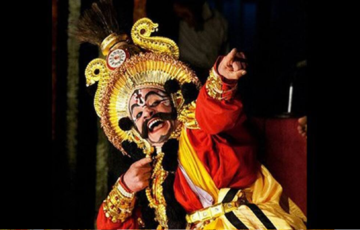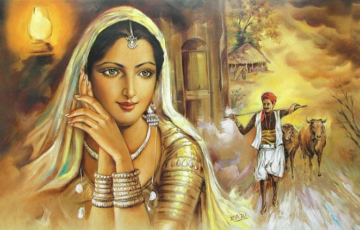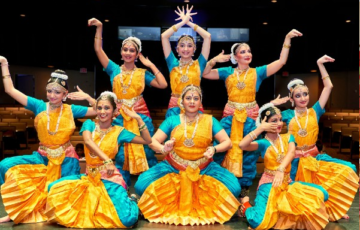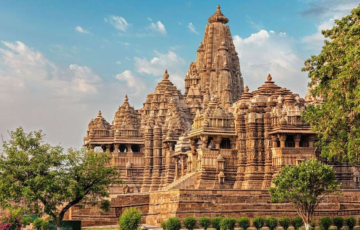INDIAN MUSIC
Introduction
- Music, often regarded as the fundamental essence of any culture, holds profound significance in India, showcasing a heritage of extraordinary artistic brilliance. According to legend, the revered sage Narada Muni is credited with introducing the art of music to Earth, along with the wisdom surrounding the universal sound known as Nada Brahma.
- Archaeological discoveries, exemplified by the unearthing of a seven-holed flute in the remnants of the Indus Valley Civilization, underscore the ancient roots of musical instruments. The Ravanahatha, believed to have originated from the Hela Civilization of Sri Lanka, stands as one of the oldest instruments in world history.
- The literary exploration of music traces back two thousand years to the Vedic era. The descending notes of the raga Kharaharapriya can be discerned in the Sama Veda, and the science of music, recognized as Gandharva Veda, serves as an Upaveda of the Sama Veda. References to musical instruments, such as the Veena, are found in the Aitareya Aranyaka, while the Jaiminiya Brahmana collectively addresses dance and music. Musicologists propose theories suggesting that the word “Om” is the origin of all ragas and notes.
- In the 4th century BC, Panini made the initial proper reference to the art of making music. However, the first comprehensive exploration of musical theory emerged in Bharata’s Natyashastra, a monumental work compiled between 200 BC and 200 AD. This historical context sheds light on the profound and enduring influence of music on the cultural fabric of India.
History of Indian Music
- The evolution of Indian music finds its profound origins in devotional practices, paving the way for significant advancements. Ritualistic music, identified as Sangama, emerged during the later Vedic period, involving the recitation of verses set to musical patterns. In the crafting of epic compositions, a narrative style of music known as Jatigan found its purpose.
- Bharata’s Natyashastra stands as the pioneering and comprehensive work elucidating musicology. Notably, it encompasses chapters defining the octave and elaborating on its 22 keys, recognized as shrutis or srutis. Dattilam, another text, supported the concept of 22 srutis per octave, suggesting these were the only ones a human body could produce. Sarangadeva, a 13th-century musicologist, echoed this perspective in his classic text, the Sangeet Ratnakara.
- The Sangeet Ratnakara, a substantial contribution, documented around 264 ragas, covering both North Indian and Dravidian repertoires. Its significant achievement lies in identifying and describing various ‘microtones,’ categorizing them distinctly. Medieval musicology texts, such as Matanga’s Brihaddeshi from the 6th-8th century, focused on defining the term ‘raga.’
- Other influential texts include Ramamatya’s Swaramela-Kalanidhi from the 16th century, primarily delving into ragas, and Venkatamakhin’s Chaturdandi-prakashika from the 17th century, renowned for crucial information on Carnatic musicology. Historical evidence also suggests the existence of Gurukuls during the ancient and early medieval periods, where students resided with teachers to master the art of music.
- The change in the essence of music was instigated by the influence of Persian elements. The integration of Islamic and Persian components had a significant impact on the musical landscape of North India. A notable example is the transition from Dhruvapad, a devotional singing style favored by rulers, to the Dhrupad style by the 15th century. By the 17th century, a new manifestation of Hindustani music had emerged, recognized as the Khayal style. Moreover, various genres of ‘folk’ singing experienced widespread growth during this period.
Anatomy of Indian Music
To understand the diverse types and genres of Indian music, a deep exploration of the fundamentals of Indian classical music is essential. The foundation of Indian classical music rests on three key components: Raga, Tala, and Swara. These elements can be elucidated as follows:
Swara:
- In ancient times, the term “Swara” was associated with the recitation of the Vedas. Over time, it evolved to signify the ‘note’ or ‘scale degree’ in a musical composition. Bharata, in Natyashastra, categorized the swaras into a 22-note scale. Presently, the notational system of Hindustani music is defined by these abbreviated swaras – Sa, Re, Ga, Ma, Pa, Dha, Ni. The amalgamation of these seven swaras is termed Saptak or Sargam. It is crucial to recognize that Swara differs from Shruti. A Shruti represents the smallest pitch gradation, indicating the quality of frequency. There are 22 Shrutis or microtones, of which only 12 are audible. Among these, seven are Suddha Swaras (Sa, Re, Ga, Ma, Pa, Dha, Ni), and five are Vikrit Swaras.
Raga:
- The term ‘raga’ is derived from the Sanskrit word ‘Ranj,’ signifying the act of delighting or bringing happiness and satisfaction to a person. Ragas serve as the foundation of melody, while talas establish the rhythm. Each melodic structure of the raga possesses qualities akin to a distinct personality, subject, and a mood evoked by the sounds.
- The fundamental element crucial for the functioning of a raga is the note on which it is based. Depending on the number of notes in the raga, three main jaatis or categories exist:
- Audav/Odava Raga: A ‘pentatonic’ raga, comprising five notes.
- Shadava Raga: A ‘hexatonic’ raga, consisting of six notes.
- Sampurna Raga: A ‘heptatonic’ raga, encompassing seven notes.
- A raga is not merely a scale or mode; it is a scientific, precise, subtle, and aesthetically melodic form with its own distinctive ascending and descending movement, incorporating either a full octave or a series of five, six, or seven notes. There are three major types of Raga or Raga Bhed:
- Shuddha Raag: In this raga, the nature and form do not change even if any notes absent from the composition are played.
- Chhayalag Raag: In this raga, playing notes not present in the original composition alters its nature and form.
Sankeerna Raag
- Sankeerna Raag is a musical composition resulting from the fusion of two or more ragas, each maintaining the fundamental five notes. Within these ragas:
- The principal note, referred to as the ‘Vaadi’ or the ‘King,’ plays a crucial role as the primary note upon which the raga is built. This note is frequently utilized in the composition.
- The second most significant note, known as the ‘Samvaadi’ or the ‘Queen,’ aligns as the fourth or fifth note in relation to the principal raga and assumes a prominent role in the composition.
- All other notes in the composition, excluding the Vaadi and Samvaadi, are termed ‘Anuvaadi.’
- Notes that are absent in the composition are recognized as ‘Vivadi.’
- The ascending sequence of notes, represented by Sa re ga ma pa dha ni, is termed ‘Aroha,’ where each note is higher than the preceding one. Conversely, the descending sequence, represented by ni, dha, pa, ma, ga, re, sa, is termed ‘Avaroha,’ with each note being lower than the preceding ones. Depending on the ascent and descent of the notes, ragas can be categorized into three speeds or Laya: Vilambit (slow), Madhya (medium), and Drut (fast).
| “Rasa” is a term in Indian aesthetics and performing arts, particularly associated with classical dance, music, and drama. The concept of Rasa refers to the emotional flavor, sentiment, or mood that a work of art evokes in the audience. It’s a complex and nuanced idea deeply rooted in ancient Indian philosophy and artistic traditions.
The Natyashastra, an ancient Indian treatise on performing arts attributed to Bharata Muni, extensively discusses the concept of Rasa. According to this text, there are nine principal Rasas, each corresponding to a specific emotional state. These Rasas are: · Shringara (romantic or erotic) · Hasya (comic or humor) · Karuna (compassion or sorrow) · Raudra (anger) · Veera (heroic or courageous) · Bhayanaka (fearful) · Vibhatsa (disgust or repulsive) · Adbhuta (amazement or wonder) · Shanta (peaceful or tranquility) The goal of any artistic performance, according to the Natyashastra, is to evoke these Rasas in the audience. This is achieved through a combination of various artistic elements such as music, dance, facial expressions, gestures, and the overall presentation of the performance. Rasa is a profound concept in Indian aesthetics that explores the emotional impact of art on the audience, and it remains a crucial aspect of classical Indian performing arts. |
Tala/Taal
- The term ‘Tala’ originates from the Sanskrit root ‘tal,’ signifying the base or pivot on which something rests. As described in Sangeet Ratnakar, where Pt. Sarangadeva provides a definition for ‘Tala,’ it is derived from the Sanskrit root ‘tal,’ comparable to the base upon which an object is fixed. Similarly, in the context of vocal, instrumental music, and dance, ‘Tala’ serves as the foundational element upon which these art forms are established.
Classical Music
Hindustani music
It is widely believed that Hindustani music began to take a distinctive form during the medieval period, with some attributing this evolution to Amir Khusro, although this viewpoint is subject to debate. The structure of Hindustani classical music was primarily designed for vocal performance, and various instruments were crafted and evaluated based on their ability to emulate the nuances of the human voice.
Key features of Hindustani classical music include:
- Primary Ragas: Six fundamental ragas in Hindustani classical music are Bhairava, Kausika, Hindola, Dipak, Sriraga, and Megh.
- Time Theory: Ragas in Hindustani classical music traditionally adhere to a strict time theory. For example, Bhairavi may be performed at dawn, while Megh is associated with the morning.
- Emotional Associations: Ragas in Hindustani music are often linked with specific feelings and moods. For instance, Bhairavi may evoke awe and fear, while Kausika is associated with joy.
- Formalized Grammar: Hindustani classical music follows a highly formalized grammar, influenced by both textual and oral traditions.
- Emphasis on Improvisation: The music places a significant emphasis on improvisation, allowing artists to explore various facets of a raga.
- Structural Components: Performances typically include a slow and leisurely introductory section (alap), followed by solfege and a faster section featuring rapid melodic phrases and rhythmic play.
- Space Between Notes: There is notable emphasis on the spaces between the notes, contributing to the distinctive character of the music.
- Persian Influence: Hindustani classical music has been notably influenced by Persian traditions, adding depth to its diverse heritage.
- Musical Instruments: Instruments commonly used in Hindustani music include Tabla, Sarangi, Sitar, Santoor, Flute, and Violin.
- Main Styles: Various styles exist within Hindustani music, such as Dhrupad, Khayal, Tappa, Chaturanga, Tarana, Sargam, Thumri, Ragasagar, Hori, and Dhamar.
This amalgamation of elements contributes to the rich and diverse tapestry of Hindustani classical music, making it a captivating and intricate art form.
Major Hindustani musical compositions and their features:
- Dhrupad:
- Ancient form evolving from Prabandha.
- Significant growth with contributions from Raja Man Singh Tomar and Emperor Akbar.
- Lyrics in Braj Basha, emphasizing veera and sringar rasas.
- Prominent gharanas: dagarvani, bishnupur, darbhanga, mallik, and bettiah.
- Gharana:
- Social organization connecting musicians or dancers through lineage and apprenticeship.
- Adherence to a specific musical style.
- Khayal:
- Persian origin, meaning ‘idea or imagination.’
- Credited to Amir Khusro and Sultan Mohammed Sharqui.
- Delicate and romantic composition with more structural freedom.
- Major gharanas: Gwalior, Kirana, Patiala, Agra, and Jaipur.
- Thumri:
- Light form inspired by Bhakti movement’s romantic-religious literature.
- Popularized under Nawab Wajid Ali Shah’s patronage.
- Folk scales, themes of Lord Krishna and Radha.
- Main gharanas: Benaras, Lucknow, and Patiala.
- Tappa:
- Originated from camel drivers’ songs, developed as a classical form.
- Known for quick turns of phrase and poetry expressing love.
- Associated with Gwalior gharana, employing Ragas like Khamaj, Jhinjhoti, Kafi, Tilang, Bhairavi, and Des.
- Ghazal:
- Influenced by Persian traditions, independent couplets.
- Predominant theme of love with Sufi elements.
- Supported by Golconda and Bijapur rulers.
- Notable singers: Begum Akhtar, Jagjit Singh, Pankaj Udhas.
- Hindustani Classical Music and Bhakti Movement:
- Played a crucial role during the Bhakti movement.
- Spread messages of love and devotion by various reformers.
- Examples include Kirtans of Chaitanya Mahaprabhu and Abhangs of Eknath, Jnanesvar, Tukaram.
Carnatic Music
- The roots of South Indian music can be traced back to prehistoric times, where musical instruments found prominence in the works of sculptors, painters, and ancient Tamil and Sanskrit texts. Carnatic music, known as Karnātaka Sangītam in Sanskrit and Tamil Isai in Tamil, is revered as “traditional” or “codified” music. Scholars employ these terms to underscore the classical and scientific foundations of this traditional musical form. Lyrics, crafted not only in Sanskrit and Tamil but also in Telugu, Kannada, and Malayalam, contribute to the rich tapestry of Carnatic music.
- Purandara Dāsa (1484-1564), a prolific poet-composer, and mystic from Vijayanagar introduced a music course that endures to this day. Since the 17th century, the organization of hundreds of rāga-s (melody types) has been undertaken within the framework of the 72 melakarta rāgas (scales). Purandaradasa, a Haridasa philosopher following Madhwacharya’s Dwaitha philosophy, is renowned for composing Dasa Sahithya. While most of his Carnatic music compositions are in Kannada, some are in Sanskrit, signed with the pen name “Purandara Vittala.”
- In the 17th century, Venkatamakhi emerged as the grand theorist of Carnatic music, devising the “Melakarta” system to classify South Indian ragas, currently comprising 72 Melakartas.
- The Musical Trinity – Tyagaraja, Muthuswami Dikshitar, and Syama Sastri – born between 1750 to 1850 A.D. in Tiruvarur, ushered in a dynamic era in Carnatic music.
Salient features of Carnatic music include:
- Indigenously developed classical music style.
- The Melakarta scheme, a comprehensive formula encompassing ancient and modern music modes worldwide.
- Strong emphasis on kriti-based compositions.
- Unity of raga, tala, and shruti in every piece.
- Equal importance given to melody and rhythm.
- Mixing three degrees of speeds.
- Fewer instruments compared to Northern Indian music, with no exclusively instrumental forms.
- A balance between re-creativity and creativity in interpretation and improvisation.
Carnatic music compositions encompass Gitam, Suladi, Svarajati, Jatisvaram, Varnam, Kritanam, Kriti, Pada, Javali, Pallavi, and more, adding to the enduring legacy of this rich musical tradition.
Various significant Carnatic compositions represent a diverse range of musical forms, each possessing distinctive characteristics:
- Gitam:
- The simplest type of composition.
- Crafted with an easy and melodious musical flow.
- Sung without repetition from start to finish.
- Typically devotional themes, occasionally praising musical luminaries and Acharyas.
- Composed in Sanskrit, Kannada, and Bhandira bhasha.
- Suladi:
- Similar to Gitam in musical structure and composition.
- Talamalika format with sections in different talas.
- Fewer sahitya syllables compared to gitas, with vowel extensions.
- Devotional themes presented in different tempos: vilambita, madhya, and druta.
- Purandaradasa has composed numerous Suladis.
- Svarajati:
- More intricate than gitas.
- Comprises three sections: Pallavi, Anupallavi, and Charanam.
- Themes can be devotional, heroic, or amorous.
- Syama Sastri, part of the Musical Trinity, was renowned for using svarajati.
- Jatisvaram:
- Noted for its rhythmic excellence.
- Belongs to the realm of dance music.
- In some Jatisvaram, Pallavi and Anupallavi are sung to jatis, while Charanas are sung to a mixture of svaras and jatis.
- Varnam:
- A complete composition showcasing characteristic phrases and melodic movements of a raga.
- Typically performed at the outset of a concert.
- Kritanam:
- Cloaked in simple music with a profound Bhakti bhava.
- Suited for both congregational singing and individual presentation.
- Kriti:
- A highly evolved musical form.
- Forms the core of a Carnatic music concert; a longer format of Carnatic song.
- Pada:
- Scholarly compositions in Telugu and Tamil.
- Initially composed as dance forms but also sung in concerts due to their musical excellence and aesthetic appeal.
- Javali:
- Belongs to the realm of light classical music.
- Exhibits a sensuous concept and spirit, reminiscent of the Thumris in Hindustani Music.
- Tillana:
- Primarily a dance form but occasionally included in music concerts as a concluding piece.
- Typically commences with jatis.
- Pallavi:
- The most crucial branch of creative music.
- Offers ample opportunities for musicians to showcase creative talents, imaginative skill, and musical intelligence.
- Tanam:
- A method of raga improvisation (manodharma).
- Suited primarily for vocal, violin, and veena.
- Serves as the second part of a Raagam Taanam Pallavi, occurring after the raga is sung but before the pallavi begins.
Folk Music
Folk music, originating from the German word “volk” denoting ‘people,’ encompasses the musical expressions of ordinary individuals, standing in contrast to established classical music. It has evolved as a traditional genre intricately interwoven with the folklore of specific regions.
Key Characteristics of Folk Music
Untraceable Origins:
- Many compositions lack a definitive trace to a singular source.
Influences:
- Songs are subject to influences such as creativity, forgetfulness, previously acquired melodies, and stylistic expectations.
- These influences can lead to variations, causing the music to either shorten or align with emerging prevalent styles.
Oral Transmission:
- The passing down of folk music knowledge primarily occurs orally, without reliance on written documentation.
Community Acceptance:
- The endurance and perpetuation of traditional folk music hinge on its acceptance within a community.
Regional Uniqueness:
- Each rendition of a song possesses uniqueness, revealing variations across diverse regions.
| Regional Music Styles and Characteristics
Rasiya Geet, Uttar Pradesh
Pankhida, Rajasthan
Lotia, Rajasthan
Pandavani, Chhattisgarh
Shakunakhar – Mangalgeet, Kumaon
Barhamasa, Kumaon
Mando, Goa
Alha, Uttar Pradesh
Hori, Uttar Pradesh
Sohar, Uttar Pradesh
Chhakri, Kashmir
Kajri, Uttar Pradesh
Qawwali
Tappa, Punjab
Powada, Maharashtra
Teej Songs, Rajasthan
Burrakatha, Andhra Pradesh
Bhakha, Jammu and Kashmir
Bhuta Song, Kerala
Daskathia, Odisha
Bihu Songs, Assam
Sana Lamok, Manipur
Songs of Lai Haraoba Festival, Manipur
Saikuti Zai (Songs of Saikuti), Mizoram
Chai Hia (Songs of the Chai Dance), Mizoram
Villu Pattu, Tamil Nadu
|
Modern Evolution of Indian Music
The late 19th and early 20th centuries marked a renaissance in Indian music, with Rabindranath Tagore introducing unique compositions known as ‘Rabindra Sangeet.’ Musicians such as Kazi Nazrul Islam, Vishnu Digamabar Paluskar, and Subramania Bharati actively contributed to the patriotic fervor of the early 20th century.
Key Developments:
- In 1901, Vishnu Digamabar Paluskar established Gandharva Mahavidyalaya in Lahore to disrupt the dominance of gharanas in classical music and broaden its influence.
- Marris College of Music, founded in Lucknow in 1926 by Vishnu Narayan Bhatkhande, played a pivotal role in revitalizing the art of music.
- An All-India music academy, initiated in 1919, aimed to facilitate research, study, and a deeper understanding of the art of music in India.
- The establishment of the Madras Music Academy in 1928 sought to reignite interest in Carnatic music.
Modernism in Indian Music:
Modernism influenced Indian music, representing a period of diverse reactions challenging and reinterpreting older musical categories. This movement led to the creation of new music genres such as Jazz, pop, freestyle, alternative R&B, etc.
Key Aspects:
- Cross-Cultural Collaborations: Indian artists collaborated with musicians worldwide, resulting in the fusion of Indian classical music with new art forms.
- Integration of Indian Instruments: In the early 1960s, Jazz pioneers like John Coltrane and George Harrison collaborated with Indian instrumentalists, incorporating Indian instruments like the sitar into their compositions.
- Rock and Roll Fusions: In the late 1970s and early 1980s, rock and roll fusions with Indian music gained popularity in Europe and North America.
These developments underscore the dynamic evolution of Indian music, embracing modern influences and fostering global collaborations.
Positives and Negatives of the Impact on Indian Music
Positives:
- Global Recognition: The extensive global acknowledgment of Indian classical music traditions is evident through the international acclaim received by artists such as Pandit Ravi Shankar, Zakir Hussain, and AR Rahman.
- Revitalization through Global Interest: From a global perspective, acclaimed artists like Shankar Tucker have shown interest in and actively contributed to the revival of Indian classical music traditions. They have introduced unique expressions like the clarinet to Western audiences.
- Increased Opportunities: Traditional Indian artists now experience expanded livelihood opportunities within the country, contributing to the preservation and continuation of their art forms.
- Cultural Enrichment: The fusion of Indian musical traditions with genres like Indie-pop has enriched and diversified the overall musical landscape.
Negatives:
- Preference for Western Music: Economic considerations have led a significant number of students to prioritize Western music over traditional Indian forms.
- Shift in Popular Tastes: Western music is gaining preference among the general population, potentially overshadowing indigenous musical preferences.
- Challenges for Traditional Artists: Traditional artists face difficulties in adapting to modern methods of composition and marketing, often lacking the resources available to Western artists.
- Threat to Livelihoods: The increasing influence of Westernization in rural areas poses a threat to the livelihoods of local artists, who may struggle to compete with globalized trends.
- Cinematic Trends: Popular cinema in various languages tends to favor Western musical forms over traditional Indian styles, contributing to a concerning trend in recent times.
MODERN DEVELOPMENTS IN MUSIC
- The progression of music in contemporary times is characterized by deviations from the dominant musical language of the early 20th century. From its origins in the early historical period, music has experienced ongoing evolution. The twenty-first century has seen significant advancements in the thriving music industry. Several institutions are now engaged in educating students about music, providing them with a theoretical and academic understanding of the subject. Moreover, there is a rising number of establishments committed to presenting the genius of artists to the public through open shows.
Significant Milestones in Music Education and Promotion
Gandharva Mahavidyalaya:
- Established in 1901 by V.D. Paluskar, this institution is dedicated to imparting knowledge of Indian classical music and dance to future generations.
- Originally situated in Lahore, it relocated to Mumbai in 1915.
- Gandharva Mahavidyalaya focuses on both Hindustani and Carnatic classical music, and its devotional orientation led to the establishment of Prayag Sangeet Samiti in Allahabad.
Prayag Sangeet Samiti:
- Founded in 1926 in Prayagraj, this institution is committed to training in Hindustani Classical music.
- Established by Deshraj Major (Dr.) Ranjit Singh, Late Baijnath Sahai, and Late Satyanand Joshi.
- Registered under the Indian Societies Registration Act of 1860, the Samiti aims to popularize Indian Classical Music and revive music that faced disrepute from the 15th to the 17th century.
Sangeet Natak Academy:
- Established in 1952 by the Government of India, it is the first national academy for the arts.
- The academy’s primary goal is to provide a framework for music, drama, and dance in India.
- Playing a crucial role in preserving India’s rich intangible heritage, the Sangeet Natak Academy focuses on music, dance, and drama.
- Collaborating with state and union territory governments, it works to promote and preserve their respective cultural heritage on a national scale.
Marris College of Music:
- Founded in 1926 by musicologist Vishnu Narayan Bhatkhande, it is one of India’s prestigious classical music institutes.
- Initially established in Lucknow, it later became the Bhatkhande Music Institute, focusing on music theory, singing, and instrumental practice.
Spic Macay (Society for the Promotion of Indian Classical Music and Culture Among the Youth):
- Established in 1977 by Kiran Seth, SPIC MACAY is a voluntary youth movement aimed at showcasing Indian culture, particularly classical music, to the younger generation.
- With a mission to promote Indian classical music, dance, and culture, SPIC MACAY organizes numerous free events targeting the general public and youth.
- Having expanded globally, with over 200 chapters or branches worldwide, SPIC MACAY plays a significant role in cultural preservation and promotion.
UPSC PREVIOUS YEAR QUESTIONS
1. Which one of the following explains the practice of Vattakirutal’ as mentioned in Sangam poems? (2023)
(a) Kings employing women bodyguards.
(b) Learned persons assembling in royal courts to discuss religious and philosophical matters
(c) Young girls keeping watch over agricultural fields and driving away birds and animals
(d) A king defeated in a battle committing ritual suicide by starving himself to death
With reference to ancient Indian History,
consider the following pairs: (2023)
| Literary work | Author | |
| 1. | Devichandragupta | Bilhana |
| 2. | Hammira-Mahakavya | Nayachandra Suri |
| 3. | Milinda-panha | Nagarjuna |
| 4. | Nitivakyamrita | Somadeva Suri |
How many of the above pairs are correctly matched?
(a) Only one
(b) Only two
(c) Only three
(d) All four
With reference to the cultural history of India,
consider the following statements: (2018)
1. Most of the Tyagaraja Kritis are devotional songs in praise of Lord Krishna.
2. Tyagaraja created several new ragas.
3. Annamacharya and Tyagaraja are contemporaries.
4. Annamacharya Keertanas are devotional songs in praise of Lord Venkateshwara.
Which of the statements given above are correct?
(a) 1 and 3 only
(b) 2 and 4 only
(c) 1, 2 and 3
(d) 2, 3 and 4
With reference to Dhrupad, one of the major traditions of India that has been kept alive for centuries, Which of the following statements are correct? (2012)
1. Dhrupad originated and developed in the Rajput kingdoms during the Mughal period
2. Dhrupad is primarily a devotional and spiritual music
3. Dhrupad alap uses Sanskrit syllables from Mantras.
Select the correct answer using the codes given below:
(a) 1 and 2 only
(b) 2 and 3 only
(c) 1, 2 and 3
(d) None of the above is correct.

